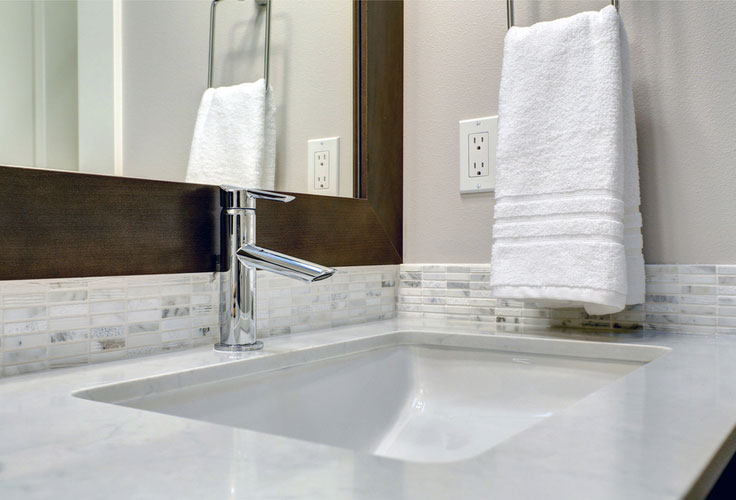To prevent calcium buildup on faucets, regularly clean them with vinegar and avoid hard water exposure. Install a water softener system to reduce mineral deposits.
Regular maintenance and simple household solutions can effectively combat calcium buildup on faucets, ensuring they remain clean and functional. Hard water, which is rich in minerals like calcium and magnesium, frequently leaves behind white, crusty deposits that can clog and damage your faucets over time.
Incorporating a gentle, acidic substance like vinegar into your cleaning routine helps dissolve these mineral deposits. Beyond regular cleaning, investing in a water softener for your home can significantly diminish hard water’s impact and prevent the accumulation of calcium on your fixtures. By proactively addressing the issue with these strategies, homeowners can maintain their faucets’ performance and appearance without engaging in extensive repairs or replacements.
:strip_icc()/BHG-How-to-Clean-a-Faucet-Head-Primary-e60925c3b4a449f8873d050cd7331f3e.jpg)
Credit: www.bhg.com
The Calcium Menace In Household Water
The Calcium Menace in Household Water strikes without warning, depositing white, crusty minerals leaching from your water supply onto your faucets and fixtures. This persistent foe can turn a gleaming bathroom or kitchen into a lackluster space riddled with stubborn white spots. Understanding and combating this challenge is crucial for maintaining a clean and efficient home.
Sources Of Calcium Deposits
Calcium buildup comes from hard water, which is rich in minerals like calcium and magnesium. This isn’t just an aesthetic issue—it’s a sign of the water quality within your pipes. A few common sources include:
- Local water supply naturally high in minerals
- Domestic water heaters that concentrate mineral content
- Evaporation of water on fixtures, leaving calcium behind
Impact On Faucets And Fixtures
Calcium deposits do more than tarnish the appearance of faucets and fixtures; they also:
| Impact | Consequence |
|---|---|
| Block Water Flow | Reduces efficiency and increases wear and tear |
| Damage Seals | Leads to drips and leaks, causing water waste |
| Corrode Parts | Shortens lifespan of fixtures and requires early replacement |
Proactive measures need to be taken to protect faucets and extend their functionality.
Spotting The Signs Of Calcium Buildup
Calcium buildup, also known as limescale, can damage your faucets. Know the signs early to avoid lasting harm to your fixtures. Preventive measures save time, money, and maintain water flow.
Visual Clues
White, crusty deposits around your faucet signal calcium buildup. These spots are hard to miss. They often form at the base or on the spout.
- Stubborn stains – They cling on despite cleaning.
- Discoloration – Signs of white or greenish scale.
Performance Issues
A faucet struggling to deliver water hints at buildup. Low water pressure may result.
- Water flow slows down.
- Sprayers and nozzles clog up.
| Sign | Effect |
|---|---|
| Reduced water pressure | Buildup in aerators |
| Odd water spray patterns | Mineral deposits altering flow |
Daily Habits To Limit Calcium Formation
Daily habits play a vital role in preventing calcium buildup on faucets. With a few simple routine steps, you can greatly reduce the hard water deposits that cause unsightly marks and hinder faucet functionality. Embrace these practices to maintain a cleaner, more efficient kitchen and bathroom environment.
Post-use Faucet Wiping
One of the simplest yet most effective methods for limiting calcium formation is to wipe your faucet after each use. Water droplets left on the surface evaporate, leaving behind calcium that can build up over time. To prevent this:
- Keep a soft cloth or towel handy near your faucet.
- Gently dry the faucet to remove moisture immediately after use.
- Ensure no water remains, especially around the spout and handles.
Regular Faucet Aerators Cleaning
Faucet aerators mix air with water to create a more even flow, but they can become clogged with calcium deposits. To keep them functioning well:
- Unscrew the aerator carefully from the faucet tip.
- Disassemble the aerator and rinse all components under water.
- Soak the parts in vinegar overnight to dissolve hard water buildup.
- Reassemble and screw the aerator back onto the faucet.
Perform this cleaning routine monthly to maintain a strong, consistent water flow and limit calcium buildup.
Diy Solutions For Calcium Removal
Calcium buildup on faucets can dull their shine. It can cause low water pressure too. You can remove it with ingredients found at home. In this section, you’ll learn about DIY solutions for calcium removal.
Natural Acidic Cleaners
Natural acidic cleaners help fight calcium deposits. They’re safe and effective. Use things like lemon juice or white vinegar. They break down calcium naturally. Apply these cleaners directly to the affected areas. Leave them on for a few minutes, then scrub gently with a brush. Rinse with water afterwards.
- Lemon juice – Squeeze directly on the faucet.
- White vinegar – Spray on or use a cloth to apply.
The Vinegar Soak Technique
For tougher buildup, the vinegar soak technique is a go-to method. It allows vinegar to dissolve the calcium deeply. Follow these simple steps:
- Fill a bag with white vinegar.
- Secure the bag around the faucet.
- Ensure the faucet is fully immersed.
- Leave it to soak for an hour.
- Remove the bag and scrub the faucet.
- Rinse it off and dry with a cloth.
This method is perfect for heavy deposits. It lets the vinegar work without hard scrubbing. Always wear gloves to protect your hands.
Maintenance Routines To Extend Faucet Life
Keeping your faucets free of calcium buildup not only preserves water flow but also extends the fixture’s life. Regular maintenance reduces the need for repairs. Simple routines can keep faucets running smoothly for years.
Monthly Deep Clean
Commit to a monthly deep clean for optimal faucet performance. Use this process:
- Mix a cleaning solution of equal parts white vinegar and water.
- Soak a cloth in the solution and wrap it around the faucet.
- Let it sit for an hour, then scrub gently with a non-abrasive sponge.
- Rinse thoroughly and dry with a soft cloth.
For tougher buildup, use a toothbrush to target crevices and joints.
When To Seek Professional Help
Sometimes, a professional’s touch is necessary. Look out for these signs:
- Stubborn deposits that resist home cleaning.
- A drop in water pressure that cleaning doesn’t fix.
- Leaks around the faucet’s base or handle.
Reach out to a plumber if these issues persist. They can address inner components that are harder to clean.

Credit: www.amazon.com

Credit: cleanzen.com
Frequently Asked Questions Of How To Prevent Calcium Buildup On Faucets
What Causes Calcium Buildup On Faucets?
Calcium buildup on faucets is typically caused by hard water, which contains high levels of minerals like calcium and magnesium.
How Can I Remove Existing Calcium Deposits?
White vinegar applied directly to the affected area can dissolve calcium deposits. Let it sit, scrub lightly, and rinse off.
Will A Water Softener Prevent Calcium Buildup?
Yes, installing a water softener can significantly reduce calcium buildup by removing minerals from your water supply.
Can Calcium Buildup Damage My Faucets?
Over time, calcium buildup can lead to corrosion, restrict water flow, and damage faucet finishes, affecting functionality and aesthetics.
Are There Natural Remedies For Calcium Removal?
Natural remedies like lemon juice or baking soda can effectively remove calcium buildup when applied and gently scrubbed on the faucets.
Conclusion
Maintaining your faucets and preventing calcium buildup is straightforward with these tips. Regular cleaning and the right choice of solutions make a difference. Embrace these habits to keep your fixtures gleaming. For more detailed guides and home maintenance advice, stay tuned to our blog.
Your sparkling faucets await!




Leave a Reply